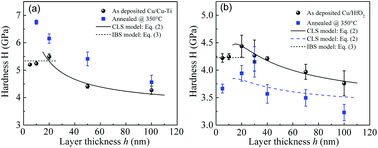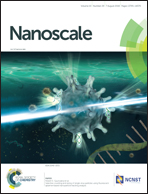Unraveling the discrepancies in size dependence of hardness and thermal stability in crystalline/amorphous nanostructured multilayers: Cu/Cu–Ti vs. Cu/HfO2
Abstract
Crystalline/amorphous interfaces (CAIs) confer outstanding mechanical properties on crystalline/amorphous nanostructured multilayers (C/ANMs), which are widely used in micro/nanodevices, because their unique interfacial structure possesses high strain compatibility. In this study, Cu/X (X = Cu–Ti, HfO2) C/ANMs with equal layer thicknesses (h) were comparatively investigated in terms of size-dependent hardness (H) and thermal stability to uncover the fundamental difference(s) between Cu/Cu–Ti and Cu/HfO2. It was found that both as-deposited Cu/Cu–Ti and Cu/HfO2 C/ANMs exhibited a maximum hardness at a critical thickness of h ∼30 nm, which was caused by a transition from confined dislocation gliding to dislocation transmission across the interface. Specifically, the Cu/Cu–Ti C/ANMs exhibited annealing hardening, whereas the Cu/HfO2 C/ANMs exhibited annealing softening associated with a minimum softening at h ∼ 30 nm, which was closely correlated with their thermal stability. In comparison with monolithic amorphous X thin films, the glassy X nanolayers in the present Cu/X C/ANMs exhibited reduced thermal stability and a trend that smaller sizes led to higher stability. The underlying mechanism of the size-dependent crystallization behavior of X nanolayers is discussed in terms of the constraining effects of the interface. These findings provide deep insights into the design of Cu/metallic-glass and Cu/ceramic-glass C/ANMs with optimal performance.



 Please wait while we load your content...
Please wait while we load your content...